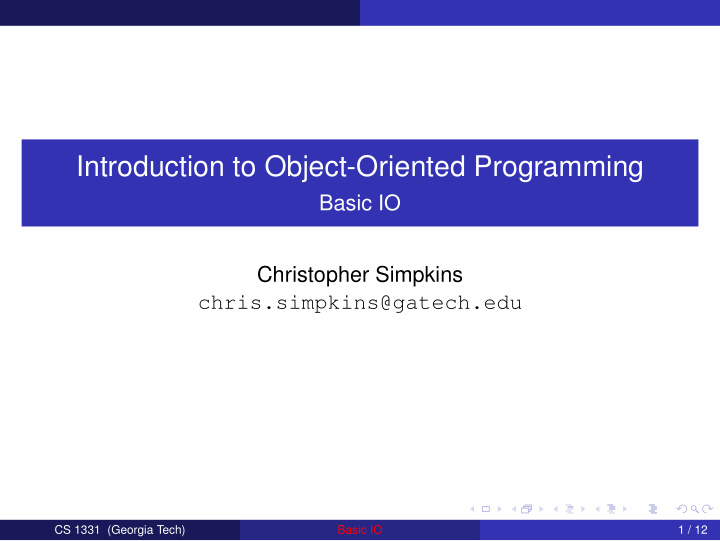



Introduction to Object-Oriented Programming Basic IO Christopher Simpkins chris.simpkins@gatech.edu CS 1331 (Georgia Tech) Basic IO 1 / 12
Screen Output The Java standard library provides three primary methods in the System.out object for sending text output to the screen. System.out.print System.out.println System.out.printf (which just calls System.out.format ) CS 1331 (Georgia Tech) Basic IO 2 / 12
System.out.print System.out.print takes a String parameter and sends the string to the screen. The statements System.out.print("Me"); System.out.print("ow!"); will produce the output Meow! CS 1331 (Georgia Tech) Basic IO 3 / 12
System.out.println System.out.println does the same as System.out.print but adds a newline character. The statements System.out.println("Johnny"); System.out.println("Chimpo"); will produce the output Johnny Chimpo CS 1331 (Georgia Tech) Basic IO 4 / 12
System.out.printf System.out.printf takes a format string and any number of additional arguments, and prints the result of inserting the additional arguments into the format string according to the format specifiers in the format string The format string can contain other text in addition to format specifiers Each format specifier begins with % and ends with a conversion character You can think of each format specifier as defining a field into which a value is inserted Like print , printf does not print a newline character at the end. End your format string with n if you want to end your output with a newline printf is a convenience method for format CS 1331 (Georgia Tech) Basic IO 5 / 12
System.out.printf Examples For full details, see http://docs.oracle.com/javase/7/docs/ api/java/util/Formatter.html#syntax . Here are a few examples “Decimals” (integers) - d , Strings - s System.out.printf("%d %s.\n", 7, "Samurai"); prints 7 Samurai. Floating point numbers - f System.out.printf("I like %3.2f.%n", Math.PI); prints I like 3.14. Play around with ConsoleOutput.java to get a feel for printf . CS 1331 (Georgia Tech) Basic IO 6 / 12
Number Formatting printf is useful for general formatting, but if you need to print currency amounts and you want to “internationalize” your code, use a CurrencyFormatter NumberFormat . NumberFormat us = NumberFormat.getCurrencyInstance(); System.out.println(us.format(3.14)); NumberFormat de = NumberFormat.getCurrencyInstance(Locale.GERMANY); System.out.println(de.format(3.14)); prints $3.14 3,14 e CS 1331 (Georgia Tech) Basic IO 7 / 12
Packages and Imports All Java classes are organized in packages We’ve been using the default package (by not specifying a package) To use a class from a different package, you must either fully qualify it every time you use it, or import it NumberFormat is in the java.text package. The top of the NumberFormat class contains the line: package java.text; And Locale is in the java.util package. So for our example from the previous slide to work we must include the following import statements at the top of our source file: import java.text.NumberFormat; import java.util.Locale; See CurrencyFormatting.java CS 1331 (Georgia Tech) Basic IO 8 / 12
Console Input You can read input from the console using the Scanner class First import it from the java.util package import java.util.Scanner; Then you can use a Scanner object to read, for example, three integers like this: Scanner keyboard = new Scanner(System.in); System.out.println("Enter your 3 test scores, separated by spaces."); exam1 = keyboard.nextInt(); exam2 = keyboard.nextInt(); exam3 = keyboard.nextInt(); examAvg = (exam1 + exam2 + exam3) / 3.0; // Why 3.0 instead of 3? System.out.printf("Your exam average is %.1f%n", examAvg); CS 1331 (Georgia Tech) Basic IO 9 / 12
Basic File Input using Scanner You can read from a file the same way you read from a keyboard by simply initializing with a File instead of System.in Scanner gradeFile = new Scanner(new File("grades.txt")); Scanner ’s hasNext method tells you whether there’s more input to consume. A common idiom for reading all the lines of a text file is: Scanner fileScanner = new Scanner(new File("ScannerFun.java")); while (fileScanner.hasNext()) { String line = fileScanner.nextLine(); // do something with line } See CourseAverage.java for a more detailed example. CS 1331 (Georgia Tech) Basic IO 10 / 12
Basic File Output using PrintStream Look up System.out in the Java API documentaion. What’s the type of System ’s out static variable? System.out is initialized to use the program’s stdout file desicriptor, which is the console if output hasn’t been redirected. We can create PrintStream s with other files or OutputStream s and write to them jsut like we’ve been eriting to the console. PrintStream outFile = new PrintStream(new File("somefile.txt")); outFile.println(...); Stop and think about this for a moment. We can write to a text file the same way we write to a text console. What general principle in computing/programming is this an example of? CS 1331 (Georgia Tech) Basic IO 11 / 12
Programming Exercise Write a program that reads all the lines of a file whose name is given at the command line, creates a new file whose file name is the original file name with “-uppercase” appended to the base name 1 , and writes all the lines of the original file to the new file but in uppercase letters. To do this, you’ll need to look up String ’s lastIndexOf , substring , toUpperCase methods in the Java API. Note: File ’s constructor throws a FileNotFoundException . For now, deal with this by appending throws Exception to the signature of any method that instantiates a File or calls a method that does so. For example, in your solution to this exercise the main method’s signature should be: public static void main(String[] args) throws Exception 1 The base name of a file is the part that appears before the extension, e.g., the CS 1331 (Georgia Tech) Basic IO 12 / 12
Recommend
More recommend